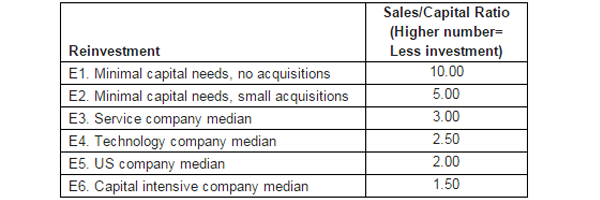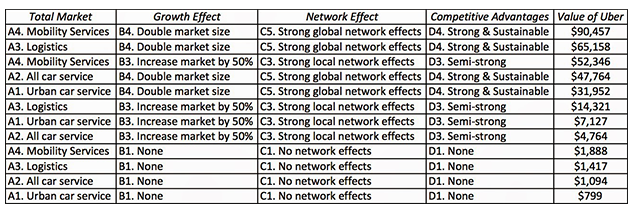In June 2014, I tried to value Uber and arrived at an estimated value for the firm of $6 billion, an impressive number for a young firm, but well below the VC estimates of value of $17-$18 billion at the time of my post. Much of the reaction was predictable, with readers whose priors were confirmed by my assessment of value liking it and those whose priors were different disagreeing,and sometimes vehemently. Disagreement and debate don't bother me in the least, since they can only advance the valuation narrative, but I do think that putting my narrative and valuation front and center undercut my objective in two ways. First, it made for passive analysis, where you could pick and choose which one of my valuation inputs you agreed with and which ones that you found erroneous, the justifying your prior biases. Second, some who disagreed took the easy way out, arguing that it was my use of an intrinsic value (DCF) model that had led me down the wrong path and that it was therefore unfixable.
Now that Uber is in the news again, with value estimates of $40 billion and higher floating around, I decided to revisit the valuation, but from a different angle. Rather than presenting my valuation, I want to open the process up and I would like to invite you along for the journey. Like a book or movie where you get to write not just the ending but the entire story, I will provide the architecture and you can build your own valuation story (and value) for Uber. The good news is that this valuation will reflect your views (not mine) on Uber. The bad news is that if you don't like the value, you cannot blame me.
When Narrative drives Value
While my original valuation of Uber was all about the numbers, I followed it up with a post where I argued that if you disagreed with my value, it was not because you had a problem with my estimates (of growth or risk) but because you were taking issue with my narrative. Underlying my original valuation was a story that I was telling about Uber as an urban cab/limo service company that would continue to attract new users into the market, while maintaining its high profit margins. In response to a post by Bill Gurley, venture capitalist investor (and director) in Uber, where I was accused of missing the story by a mile, I conceded that I knew far less than he did about the company and that his narrative for the company - Uber as a car-service for the masses with global networking benefits - would lead to a much higher value for the company.
While that may sound abstract, the best way to see the link between story telling and number crunching is to take Uber on the valuation process, with you making your judgments at each step of the way. As you make this journey, a few (gentle) reminders of issues that you will face along the way:
1. This is your valuation: Contrary to what you might have been taught in your valuation classes, valuations are and should never be just about the numbers. To the extent that you will be making choices on these number, this will be your estimate of valuation, reflecting not only what you know about the company (and its products, management etc.) but also your personal biases (whether you like the company or not).
2. You are almost certainly wrong: Lest you view this is an insult, so is my assessment of value and so are the VC’s valuations. It is not because we don't understand valuation or have not done our homework, it is because we are trying to play God and forecast the future.
3. You should be open to revisiting it: Following up on the last proposition, it stands to reason that the choices you make in valuing Uber today will not be the choices that you will make tomorrow or a week from now. So, keep the door open for changes not just at the margins but in your central narrative.
4. Be willing to act on it: There is no point to valuing companies, if you are not willing to act on your valuations. With Uber, it is true that you and I are restricted in what we can do, since the company is still private. However, it is also clear that the explosive growth in the estimated value of the company sets it on a path to being public (sooner, rather than later), at which point our valuations will become actionable.
Setting the stage
The first step in valuation is assessing where the company is right now and we start off at a disadvantage, because it is amazing how little we know about the operating details of a company that is in the news as much as Uber. According to the company's website, it operates in 51 countries and in about 230 cities on six continents, and it has also expanded its product offerings, both within the car service market (with U4B, directed at businesses and UberPool, allowing for car pooling)and in new markets (with UberRUSH, its delivery service in New York City).
The only updated revenue numbers came from an article in Business Insider, which seems to be one the company's preferred venues for leaking selective information. According to the article, the company projects gross receipts of $10 billion in 2015, up three times from gross receipts in 2014, which in turn more than tripled relative to receipts in 2013. While the company originally kept 20% of these receipts as revenues, it is unclear whether that number has slipped in recent months, as it has gone aggressively for new growth. While I am normally loath to value companies based upon second-hand information, and especially so if the information comes from a leaked corporate document, I am going to assume that the company will generate $3.5 billion in gross receipts for 2014 and that its slice has stayed at 20%, giving it revenues of $700 million for the year. I have no idea whether it is profitable after covering its operating costs, but the impact on the final value of these initial numbers is small enough that it is worth moving forward.
Building your Uber narrative
To set up the link between the narrative that you will be telling for Uber and its value, I will borrow the set-up that I used in this post on narrative and numbers, where I took the key inputs into my valuation and connected them to stories told about companies:

There are thus six steps to the narrative process and your choices at each step will determine the numbers from which we estimate value.

Step 1: Potential Market
In my initial valuation of Uber, I treated it as an urban car-service company and was taken to task rightly for having too cramped a vision of the company. It is quite clear from both its words and actions that Uber has much larger designs and I will leave it to your judgment whether it will succeed. Based on rudimentary research of the potential markets that Uber could be in, here is what I get as a list:

The potential starting market can range from $100 billion (for urban car service) to close to $300 billion (if you treat it as transportation company, going after all of the markets above). Since this is your narrative, its your choice to make and it will have significant value consequences.
Based on what you know (and think about) Uber, which of the following do you think is its potential market?

Step 2: Market Growth
Uber is not only disrupting the existing players in the market that it disrupts but it is also attracting new users into the market, either by attractive non-cab users to try Uber or increasing the usage of car services, in general. Assuming that this process continues, the growth rates in these markets could increase if Uber's services (or Uber-like services) become more widely accessible. Here again, the choice is yours.
Based on the potential market(s) you chose for Uber in step 1, what effect do you see Uber (and Uber-like services) having on the expected growth rate in the market?

Step 3: Market Share
Having chosen a potential market and a growth rate in that market, the third step is making a judgment on what market share you would expect Uber to command once the market hits steady stay (in ten years). That choice will depend in large part on whether you think Uber's products/services have network effects, where increased usage of Uber by customers in a market makes it more attractive to other potential customers, and whether you think these network effects are local (in the city/region of usage) or global (in other cities/regions). The arguments for local network effects are easy (the more Uber users there are, the more Uber cars there are, which in turn makes it easier/quicker to get an Uber ride) but the ones for global network benefits may be more of a stretch (links to credit cards, inertia, uniformity of service, staying with the known). Once you have assessed the pluses and minuses, here are your choices.
Based on your assessment of Uber, what type of network effect (if any) do you see for its products and services?

Step 4: Revenue Slice & Operating Costs
Uber gets to keep a portion of the gross receipts paid by users for an Uber service, representing their revenues. That slice was initially set at 20% of the receipts but whether it can stay at that level will depend upon both the markets that Uber decides to operate in and the competition within each market. Thus, if Uber decides to go into the logistics market (moving and local delivery), it will have to accept a much lower slice of revenues, since competition is more intense. Even within the urban car service market, more intense competition from existing players (Lyft) or new entrants could put Uber's revenue slice under pressure. This choice again is yours to make:
Given the markets that you see Uber entering and the competition it faces within those markets, how strong and sustainable are Uber's competitive advantages?

Step 5: Reinvestment Needs
Uber's existing business model, where it acts as an intermediary and does not invest in cars or equipment, has low capital intensity and as a consequence, much of its growth has come with relatively low reinvestment. That could change, if Uber decides to change its business model or if it has to do acquisitions to continue to generate growth.
Based on the business model that you see Uber adopting as it goes for the market share (that you forecast) in your potential market, which of the following reinvestment policies best fits the company?

Step 6: Risk (Cost of capital & Survival risk)
As I noted in the table above, there are types of risk that you have to grapple with in valuation. The first is the risk in operations, which causes revenues and earnings to be volatile over time, and that risk is captured in the risk-adjusted return you demand for investing in the company. In valuation, the cost of capital becomes the measure of this risk-adjusted return and is generally estimated by looking at publicly traded companies (even though Uber is privately held still). Rather than wrestle with the minutiae of inputs into the model, you can make a judgment on where in the cross-sectional distribution of costs of capital across all companies you would put Uber.
Based on your assessment of the risk in the market that Uber is entering and where the company is in its life cycle, what cost of capital would you pick for the company?

The other risk for a young company is survival risk, i.e., the risk that you are one disaster from shutting operations. That risk increases for smaller companies with small cash holdings, large cash needs and limited access to capital. Given Uber's capacity to raise capital and cash holdings, this risk should be lower.
Your Uber value
Once you have made the choices on the potential market, growth in that market, Uber's market share and revenue slice, the valuation follows. While the number of combinations of assumptions is prohibitively high to show value estimates under each one, I have summarizes the value estimates for at least a subset of plausible choices. (using a sales to capital ratio of 5.00 and a cost of capital of 12% for all the cases)>

If your set of assumptions is not listed above, you can download the spreadsheet, enter your choices and see what the value of Uber is with those choices. If you don't like the value that you get with your narrative choices, I am afraid that it is just a reflection of your choices.
Looking at the range of values that you can obtain ($799 million to $90.5 billion), you may find your worst fears about DCF models, i.e., that they can be used to deliver whatever number you want, vindicated, but that is not the way I see it. Instead, here are four lessons that I draw from this table:
1. Soaring narratives, soaring values: I know that some people view DCF models as inherently conservative and thus unsuited to valuing young companies with lots of potential. As you can see in the table above, if you have a soaring narrative of a huge market, a dominant market share and hefty profit margins, the model will deliver a value to match. Put differently, if you found my original valuation of Uber too low, the fault lies with me for having a cramped vision of what Uber can accomplish and not with the model. It also stands to reason that when you have big differences in value estimates, it is almost always because you have different narratives for a company, not because you have a disagreement on an input number.
2. Not all narratives are made equal: While I have listed out multiple narratives, some of which deliver huge values and some not, not all are equal. Looking forward as investors, some narratives are more plausible than others and thus have better odds of succeeding. Looking back ten years from now, reality will have delivered its own story line for Uber and the narrative that came closest to that reality will be the winner.
3. Narratives need reshaping: The narratives for Uber that you developed are based on what you know today. As events unfold, it is critical that you check your narrative against the facts and tweak, change or even replace the narrative if the facts require those adjustments, which was the point that I made in this post.
4. Narratives matter: Success, when investing in young companies, comes from getting the narrative right, not the numbers. That may explain why some successful venture capitalists can get away being surprisingly sloppy with they numbers. After all, if your skill set includes finding start-ups with strong narratives and picking founders/entrepreneurs who can deliver on those narratives, the fact that you cannot tell the difference between EBITDA and free cash flow or compute the cost of capital will be of little consequence.
If you are waiting for me to reveal my narrative choices, you will be disappointed. This is your valuation, not mine, and I hope that you like it. If you could please go in and put your narrative choices and resulting value for Uber into this shared Google spreadsheet, we can get a crowd valuation of Uber!
This article first appeared in Aswath Damodaran's blog.
(Aswath Damodaran is a professor of finance at the Stern School of Business at NYU.)
To become a guest contributor with VCCircle, write to shrija@vccircle.com.







